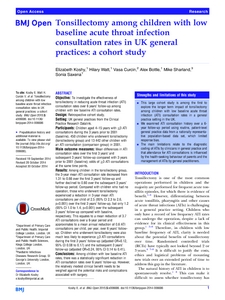Koshy, E; Watt, H; Curcin, V; Bottle, A; Sharland, M; Saxena, S
(2015)
Tonsillectomy among children with low baseline acute throat infection consultation rates in UK general practices: a cohort study.
BMJ Open, 5 (2).
e006686.
ISSN 2044-6055
https://doi.org/10.1136/bmjopen-2014-006686
SGUL Authors: Sharland, Michael Roy
![[img]](https://openaccess.sgul.ac.uk/107379/1.hassmallThumbnailVersion/Tonsillectomy_among_children_low_baseline_acute_throat_infection_consultation_rates.pdf)  Preview |
|
["document_typename_application/pdf; charset=binary" not defined]
Published Version
Download (646kB)
| Preview
|
Abstract
OBJECTIVE: To investigate the effectiveness of tonsillectomy in reducing acute throat infection (ATI) consultation rates over 6 years' follow-up among children with low baseline ATI consultation rates.
DESIGN: Retrospective cohort study.
SETTING: UK general practices from the Clinical Practice Research Datalink.
PARTICIPANTS: Children aged 4-15 years with ≤3 ATI consultations during the 3 years prior to 2001 (baseline). 450 children who underwent tonsillectomy (tonsillectomy group) and 13 442 other children with an ATI consultation (comparison group) in 2001.
MAIN OUTCOME MEASURES: Mean differences in ATI consultation rates over the first 3 years' and subsequent 3 years' follow-up compared with 3 years prior to 2001 (baseline); odds of ≥3 ATI consultations at the same time points.
RESULTS: Among children in the tonsillectomy group, the 3-year mean ATI consultation rate decreased from 1.31 to 0.66 over the first 3 years' follow-up and further declined to 0.60 over the subsequent 3 years' follow-up period. Compared with children who had no operation, those who underwent tonsillectomy experienced a reduction in 3-year mean ATI consultations per child of 2.5 (95% CI 2.3 to 2.6, p<0.001) over the first 3 years' follow-up, but only 1.2 (95% CI 1.0 to 1.4, p<0.001) over the subsequent 3 years' follow-up compared with baseline, respectively. This equates to a mean reduction of 3.7 ATI consultations over a 6-year period and approximates to a mean annual reduction of 0.6 ATI consultations per child, per year, over 6 years' follow-up. Children who underwent tonsillectomy were also much less likely to experience ≥3 ATI consultations during the first 3 years' follow-up (adjusted OR=0.12, 95% CI 0.08 to 0.17) and the subsequent 3 years' follow-up (adjusted OR=0.24, 95% CI 0.14 to 0.41).
CONCLUSIONS: Among children with low baseline ATI rates, there was a statistically significant reduction in ATI consultation rates over 6 years' follow-up. However, the relatively modest clinical benefit needs to be weighed against the potential risks and complications associated with surgery.
Statistics
Item downloaded times since 24 Apr 2015.
Actions (login required)
 |
Edit Item |



